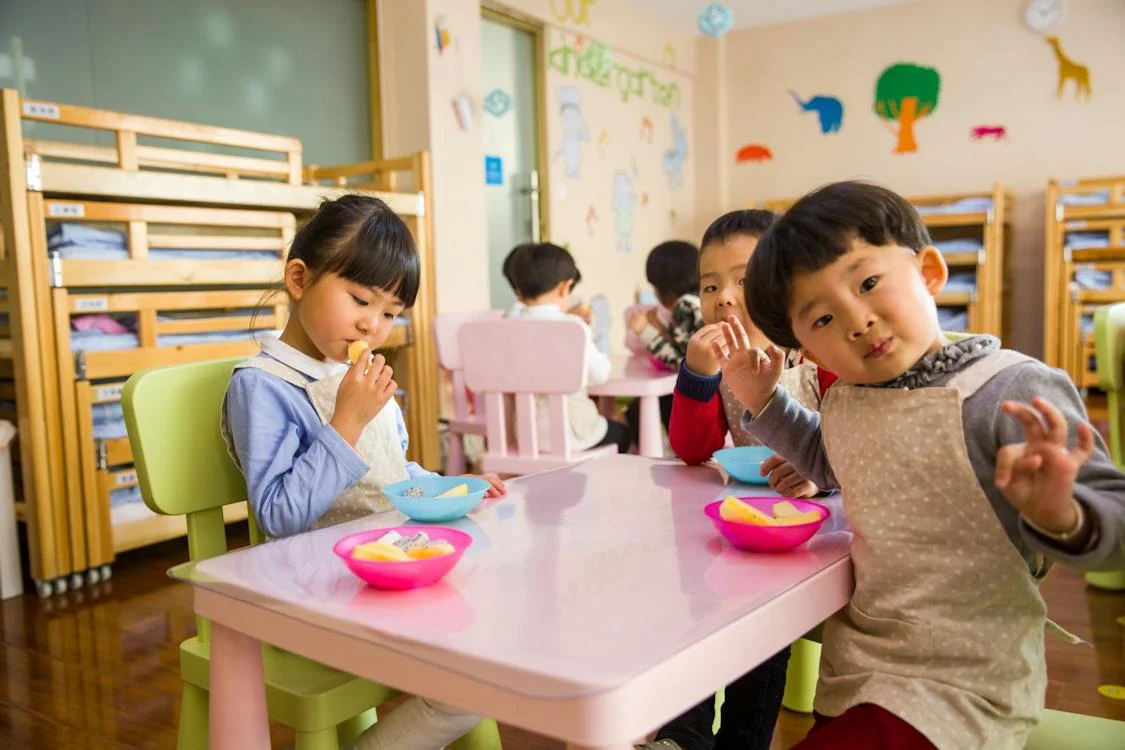The thought of leaving your baby with someone else, especially a stranger, can be daunting. But hey, you’re not alone. Offloading childcare duties is a big parenting decision to make, but a lot of people do that. If you’re a mother planning to go back to work, you’ve got lots of company. According to some estimates, more than 70% of primary caregivers work outside the house, which means there are plenty of childcare options, like hiring babysitters or nannies.
One of the best options is a daycare, either a group center or a home daycare. Many centers offer exceptional care with licensed and trained caregivers and staff in an environment that can offer your child learning and socialization with other kids their age.
Looking for the best daycare option for your child can be an overwhelming task, and it can be stressful for moms. But don’t get discouraged – there are some tips and tricks to help you look for the most suitable daycare for your situation.
Things to Look for When Choosing a Daycare
Location
You’ll want to choose a conveniently located daycare, either close to your home or workplace. This will make drop-offs and pick-ups easier and save you time and money on transportation.
If you’re driving to your workplace every day, it’s best to find a daycare that is also on the way to and from work. This way, if you’re 10-15 minutes behind your schedule, it will still be convenient because it’s right along your work route. And at the end of the day, as you want to get home, you don’t need to add extra minutes to your commute by going out of your way to pick up the kids.
Positive reviews and recommendations
Look for a daycare with a good reputation and positive reviews from other parents. You can find legitimate reviews on websites like Care.com, Winnie, and even local parent groups on Facebook. Ask your daycare to provide you with names and numbers of parents you can call for references. You can also ask your family and friends which local center they can recommend.
If you are eyeing a daycare center, check them out online. Most daycare centers come with Facebook pages, so read what they are posting and pay attention to what parents are saying as well. Pay attention to any red flags.
Hours of operation
Check if the daycare’s hours of operation fit with your work schedule and if they offer extended hours in case you need to work late. Most daycare centers stay open for about 12 hours a day to support different parent schedules.
Safety and security
This one’s a no-brainer. A daycare with extra security measures put in place is important because these are children that they will be keeping inside. The facility should have locked doors to ensure that no unauthorized person can come in and pick up a child. There should also be clearly defined drop-off and pick-up procedures to ensure that only authorized people are allowed to pick up children. Some daycare centers have doors that automatically lock, and parents or caregivers are given a key chip or fob to swipe in. Otherwise, you’ll have to ring a bell so you can be let inside.
Good daycare centers go above and beyond to ensure the safety of the children, which includes childproofing, food safety practices, a well-maintained play area with sets of toys, and constant supervision. A safe daycare center will have the following:
- Covered electrical outlets
- Cribs that are out of reach from windows or blinds
- Stairs locked with a baby gate
- Changing tables and high chairs with straps
- Clean toys in good condition
- No small objects that can be a choking hazard for babies
- No fluffy bedding or pillows in cribs, as babies must be put to sleep on their backs
- Enclosed outdoor space for play
- Clean floors
- Smoke detectors, fire extinguishers, and clearly marked exits
Clean setting
A good daycare center spells out its health and sanitation rules on a visible sign and then follows them. Some cleanliness protocols to look out for include:
- Caregivers washing hands after every diaper change
- The diapering and food preparation areas must be kept separate
- Feeding utensils are washed in a dishwasher or are disposable
- Pacifiers, teething rings, and washcloths should not be shared
- Toys are rinsed off with a sanitizing solution, or each child gets a separate box for toys
- Bottles are prepped under sanitary conditions
- All adults and children wash their hands after entering the classroom
Qualified and caring caregivers
You must also assess the teachers and staff in the daycare during your visit. Make sure to learn more about the educational background and qualifications of the teachers when it comes to working with kids. Find out if they are certified in CPR and first aid and have undergone health and criminal background checks.
Observe how they interact with their students. Observe if they have an engaging interaction with the children and if the kids respond well to them. Notice their body language, actions, and words they use as they communicate with the children.
Beyond their interactions with the teachers, do the teachers make you feel comfortable? Are they communicative enough with you as you are concerned with caring for and educating your children? If so, you’re more likely to look in the right direction.
Also, consider employee turnover. Ask how long the teachers and caregivers have been on staff. High staff turnover is a bad sign, as it could mean that they aren’t paid well or aren’t qualified for child care.
Stimulating and happy environment
You will sense it right when you walk in the door. Does the daycare look clean, vibrant, and fun for children? Take a look at the environment and see if they are welcoming, cozy, and reflective of the diversity of the children they cater to. Check if they have age-appropriate environments, like plenty of floor space for crawlers or babies who need tummy time and ample desks and chairs for arts and crafts for preschool children.
As you visit a daycare center, observe if the kids seem happy and engaged. Do you see displays of what the children are doing and learning? Are children encouraged to explore and make choices? Are they responsive and comfortable with the caregivers? Do the staff get down on the floor and interact with children closely?
Program and curriculum
No matter how young your child may be, starting age-appropriate learning is never too early. When you’re looking for daycare, determine what you prefer for your child and take some time to learn their program and curriculum. Find out if they have a loose, fluid, child-led schedule or if they have a more school-like or Montessori-like educational environment. Ask about their teaching goals and if programs are tailored according to children’s age and developmental stage.
Make sure the daycare offers ample time for play because it’s important for their holistic growth. Check the rundown of daily activities; you must see lots of talking, reading, singing, dancing, and playtime activities. See if you can get updates on your child’s progress and how.
Separation of age groups
An important thing to look for in daycare is the opportunity for your children to be stimulated in different ways. Check if there are separate spaces or rooms for infants, toddlers, and preschoolers so they can learn with and from their peers. Babies under 12 months shouldn’t be left mingling with toddlers and older kids, as they can be pretty rambunctious and may not be gentle with infants.
Most childcare facilities come with transitional spaces from an infant room to a toddler room to a preschool room. These transitions are generally separated based on the age of the children and the capacity of each room to meet child-to-teacher ratios.
Low child-to-caregiver ratios
When it comes to daycare centers, the more hands on deck, the better. Since babies and toddlers need lots of attention, ensure the facility sets limits on how many children they can accommodate depending on the number of caregivers. Ratio requirements may vary by location, but you must always look for more trained adults for younger children and babies.
You should see a high amount of caregivers per group of children. For instance, infants under 15 months old with a group size of eight or fewer must have one caregiver for every four babies. For toddlers up to 2 ½ years old with a group size of 10 or less, there must be one for every four toddlers. Meanwhile, for preschool-aged kids with a group size of 10 or less, there should be one for every six kids. Ideally, you’d also want to have the same caregivers day in and day out.
Open door policy
Daycare facilities must have open-door policies. This means that parents and caregivers can drop by anytime it’s open for whatever reason. Of course, parents should respect the daycare’s usual schedule and not drop by frequently, which can disturb the flow of the program and care their children are receiving, like naptime. It’s best to pick a daycare that allows you to stop by just because or pick up your child early if you want to.
Before making a final choice, consider dropping by unannounced to any daycare you’re considering. It gives you a truer picture of what it’s like when the staff isn’t prepped for incoming visits.
Parental involvement
Trusting another person to take care of your child can be a struggle, which is why a good daycare offers access to teachers when you want to check in or need something. You’ll want a facility that gives you feedback about your child’s day.
Check how accessible they are. You must be able to reach someone at the daycare center anytime while your child is there. It doesn’t matter if it’s an emergency, a question, a concern, a reminder, or to see how your child is going – they should make sure that your calls are always answered promptly.
Find out how involved parents can be in their child’s care and education and whether the daycare encourages communication between parents and staff.
Cost
Daycare centers are often less expensive than private childcare, but typically, it’s still pricey unless your company or your government subsidizes it. Some companies offer daycare as a perk for their employees, and it’s good to grab that opportunity to lessen your expenses, especially if the daycare is very close to your workplace.
If you have only one child who needs care and attention while you’re away, a daycare is a less expensive choice than hiring a nanny. But a nanny may be more cost-effective if you have multiple kids.
Consider the cost of the daycare, including any additional fees, and whether they offer any discounts or financial assistance. You don’t want to put your kids in a daycare that you can’t afford or settle on a less-quality daycare if you can afford a good one that’s close to you.
Policies
Find out what their policies are on discipline, food and snacks, health standards, illness, medication, TV, and sleeping. They must have written policies for these things. These are some questions you may need to be answered regarding their policies:
- Do they have discipline tactics that are the same as yours?
- Do they offer time-outs or consequences for bad toddler behavior?
- How do they handle babies who are extremely fussy or want to be held all the time?
- Do they provide healthy snacks or offer packed foods loaded with sugar?
- What type of baby foods do they feed babies aged 6-12 months old?
- When do they offer naps?
- Will the TV be the babysitter, or will they restrict the amount allowed to watch?
- What are their policies regarding immunizations?
- How do they handle sick kids? What are their guidelines for kids who become ill under their care?
Licensing and accreditation
Check if the center is licensed or registered with the proper government agencies. Each state differs in basic legal requirements for operating a daycare. Are they accredited or in the process of getting accreditation? It’s best to stick with properly accredited and licensed daycare centers for your peace of mind.
Gut feeling
Do not ignore your gut feeling when choosing a daycare. First impressions are important, so if you feel like something isn’t right, then something probably isn’t. Dropping your baby off that place can be tough, so you want to feel as comfortable and at ease as much as possible. Follow your instincts when interviewing potential caregivers. Visit several daycare centers and consider choosing the one whom you feel most at peace with.
Conclusion
The best daycare center has the combination of the items listed above while also checking some of the boxes in your personal list. Make sure that you feel happy and secure with the facility where you plan to leave your child every day. Remember, the teachers, caregivers, and friends they meet there are their first away-from-home family, so you have to choose carefully.






